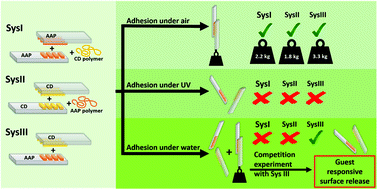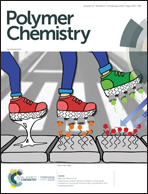Responsive surface adhesion based on host–guest interaction of polymer brushes with cyclodextrins and arylazopyrazoles†
Abstract
Three supramolecular adhesive systems based on the host–guest interaction of β-cyclodextrins (β-CD) with photoresponsive arylazopyrazoles (AAP) are reported. Glass substrates and silicon wafers were functionalized either with β-CD or AAP containing polymer brushes by microcontact printing and surface initiated atom transfer radical polymerization (SI-ATRP). Two host or guest surfaces were glued by incubation with the complementary guest or host polymer. In addition, complementary surfaces functionalized with guest and host polymer brushes were glued together. The adhesion strength of the three systems was investigated in air as well as under water and UV irradiation. All systems show strong supramolecular adhesion in air due to multivalent host–guest interaction. The system based on two complementary surfaces has excellent water resistance, adhesion can be de-activated by irradiation with UV light, and adhesion can be reversed using a competitive guest, but no direct photo-release was observed due to a hindered photo-isomerization in the nanoscale confinement of the polymer brushes sandwiched between two adhering substrates.



 Please wait while we load your content...
Please wait while we load your content...